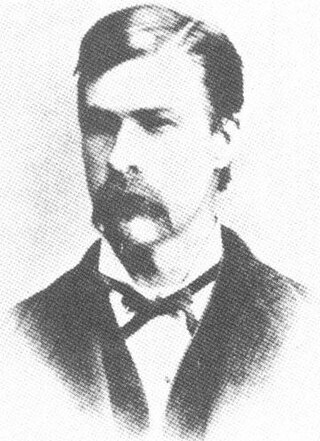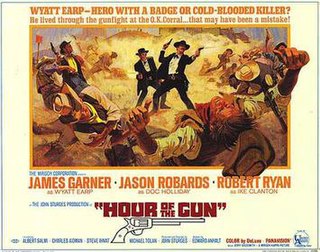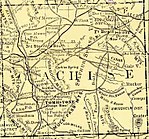Related Research Articles

The gunfight at the O.K. Corral was a gunfight that lasted less than a minute between lawmen led by Virgil Earp and members of a loosely organized group of outlaws called the Cowboys that occurred at about 3:00 p.m. on Wednesday, October 26, 1881, in Tombstone, Arizona, United States. It is generally regarded as the most famous gunfight in the history of the American Old West.

Virgil Walter Earp was both deputy U.S. Marshal and Tombstone, Arizona, City Marshal when he led his younger brothers Wyatt and Morgan, and Doc Holliday, in a confrontation with outlaw Cowboys at the Gunfight at the O.K. Corral on October 26, 1881. They killed brothers Tom and Frank McLaury and Billy Clanton. All three Earp brothers had been the target of repeated death threats made by the Cowboys who were upset by the Earps' interference in their illegal activities. All four lawmen were charged with murder by Ike Clanton, who had run from the gunfight. During a month-long preliminary hearing, Judge Wells Spicer exonerated the men, concluding they had been performing their duty.

Tombstone is a 1993 American Western film directed by George P. Cosmatos, written by Kevin Jarre, and starring Kurt Russell and Val Kilmer, with Sam Elliott, Bill Paxton, Powers Boothe, Michael Biehn, and Dana Delany in supporting roles, as well as narration by Robert Mitchum.

Morgan Seth Earp was an American sheriff and lawman. He served as Tombstone, Arizona's Special Policeman when he helped his brothers Virgil and Wyatt, as well as Doc Holliday, confront the outlaw Cochise County Cowboys in the Gunfight at the O.K. Corral on October 26, 1881. All three Earp brothers had been the target of repeated death threats made by the Cowboys who were upset by the Earps' interference in their illegal activities. The lawmen killed Cowboys Tom and Frank McLaury and Billy Clanton. All four lawmen were charged with murder by Billy's older brother, Ike Clanton, who had run from the gunfight. During a month-long preliminary hearing, Judge Wells Spicer exonerated the men, concluding they had been performing their duty.
Lou Cooley was a cowboy, and alleged gunfighter who took part in the Earp-Clanton feud in Tombstone, AZ from 1880–1882.

William Brocius, better known as Curly Bill Brocius, was an American gunman, rustler and an outlaw Cowboy in the Cochise County area of the Arizona Territory during the late 1870s and early 1880s. His name is likely an alias or nickname, and some evidence links him to another outlaw named William "Curly Bill" Bresnaham, who was convicted of an 1878 attempted robbery and murder in El Paso, Texas.

Joseph Isaac Clanton was a member of a loose association of outlaws known as The Cowboys who clashed with lawmen Wyatt, Virgil and Morgan Earp as well as Doc Holliday. On October 26, 1881, Clanton was present at the Gunfight at the O.K. Corral in the boomtown of Tombstone, Arizona Territory but was unarmed and ran from the gunfight, in which his 19-year-old brother Billy was killed.

Newman Haynes Clanton, also known as "Old Man" Clanton, was a cattle rancher and father of four sons, one of whom was killed during the Gunfight at the O.K. Corral. Two of his sons were involved in multiple conflicts in Cochise County, Arizona Territory including stagecoach robbery and cattle rustling. His son, Ike Clanton, was identified by one witness as a participant in the murder of Morgan Earp. Billy Clanton and Ike were both present at the Gunfight at the O.K. Corral in which Billy was killed. "Old Man" Clanton was reportedly involved with stealing cattle from Mexican ranchers and re-selling them in the United States. Records indicate he participated in the Skeleton Canyon Massacre of Mexican smugglers. In retaliation, Mexican Rurales are reported to have ambushed and killed him and a crew of Cowboys in the Guadalupe Canyon Massacre.

The Earp Vendetta Ride was a deadly search by a federal posse led by Deputy U.S. Marshal Wyatt Earp for a loose confederation of outlaw "Cowboys" they believed had ambushed his brothers Virgil and Morgan Earp, maiming the former and killing the latter. The two Earp brothers had been attacked in retaliation for the deaths of three Cowboys in the Gunfight at the O.K. Corral on October 26, 1881. From March 20 to April 15, 1882, the federal posse searched southeast Cochise County, Arizona Territory for the men they believed were responsible for the attacks on Virgil and Morgan. Several suspects had been identified and were charged, but were soon released by the court, owing in some cases to legal technicalities and in others to the strength of alibis provided by Cowboy confederates. Wyatt hoped that the legal system would bring the Cowboys to justice, but after suspects in both ambushes were freed, Wyatt resolved to take matters into his own hands.
Sherman McMaster (1853–1892) was an outlaw turned lawman, who was one of the six men involved in the Earp vendetta ride.

Hour of the Gun is a 1967 Western film depicting Wyatt Earp and Doc Holliday during their 1881 battles against Ike Clanton and his brothers in the Gunfight at the O.K. Corral, and the gunfight's aftermath in and around Tombstone, Arizona, starring James Garner as Earp, Jason Robards as Holliday, and Robert Ryan as Clanton. The film was directed by John Sturges.
Michael O'Rourke, aka "Johnny O'Rourke" or "Johnny-Behind-the-Deuce", was a professional gambler of the Old West. While living in Charleston, Arizona, he killed Henry Schneider, a popular mine engineer, in what O'Rourke said was self-defense. But citizens were aroused and threatened to lynch O'Rourke. Constable George McKelvey took O'Rourke to Tombstone, chased by the angry mob. Once there, Deputy U.S. Marshal and Tombstone Police Chief Virgil Earp, his brother Wyatt, Cochise County Sheriff Johnny Behan, and others saved him from the crowd.
The Jesse Evans Gang, also known as The Boys, was a gang of rustlers and robbers led by outlaw and gunman Jesse Evans, which lasted from 1876 until 1880. The gang was formed after Evans broke with the John Kinney Gang. After breaking away, he brought along with him Billy Morton, Frank Baker, Tom Hill, Dolly Graham, George Davis, Jim McDaniels, Buffalo Bill Spawn, Bob Martin, Manuel "Indian" Segovia and Nicholas Provencio.

Tom McLaury was an American outlaw. He and his brother Frank owned a ranch outside Tombstone, Arizona, Arizona Territory during the 1880s. He was a member of a group of outlaws Cowboys and cattle rustlers that had ongoing conflicts with lawmen Wyatt, Virgil, and Morgan Earp. The McLaury brothers repeatedly threatened the Earps because they interfered with the Cowboys' illegal activities. On October 26, 1881, Tom and Frank were both killed in the Gunfight at the O.K. Corral in Tombstone, Arizona Territory. The Tombstone shootout was his only gunfight.

William Harrison Clanton was an outlaw Cowboy in Cochise County, Arizona Territory. He, along with his father Newman Clanton and brother Ike Clanton, worked a ranch near the boomtown of Tombstone, Arizona Territory and stole livestock from Mexico and later U.S. ranchers.

The Cochise County Cowboys is the modern name for a loosely associated group of outlaws living in Pima and Cochise County, Arizona in the late 19th century. The term "cowboy", as opposed to "cowhand," had only begun to come into wider usage during the 1870s. In that place and time, "cowboy" was synonymous with "cattle rustler". Such thieves frequently rode across the border into Mexico and stole cattle from Mexican ranches that they then drove back across the border to sell in the United States. Some modern writers consider them to be an early form of organized crime in America.

Cochise County in southeastern Arizona was the scene of a number of violent conflicts in the 19th-century and early 20th-century American Old West, including between white settlers and Apache Indians, between opposing political and economic factions, and between outlaw gangs and local law enforcement. Cochise County was carved off in 1881 from the easternmost portion of Pima County during a formative period in the American Southwest. The era was characterized by rapidly growing boomtowns, the emergence of large-scale farming and ranching interests, lucrative mining operations, and the development of new technologies in railroading and telecommunications. Complicating the situation was staunch resistance to white settlement from local Native American groups, most notably during the Apache Wars, as well as Cochise County's location on the border with Mexico, which not only threatened international conflict but also presented opportunities for criminal smugglers and cattle rustlers.

Robert Havlin Paul, commonly known as Bob Paul, was a law enforcement officer in the American Southwest for more than 30 years. He was sheriff of Pima County, Arizona Territory, from April 1881 to 1886. He was also a friend of Deputy U.S. Marshall Virgil Earp and his brother Wyatt Earp. At 6 feet 6 inches (1.98 m) and 240 pounds (110 kg), he was described as "larger than life". Others described him as "powerful, fearless and very lucky".
Phineas Fay Clanton was the son of Newman Haynes Clanton and the brother of Billy and Ike Clanton. He was witness to and possibly played a part in a number of illegal activities during his life. He moved frequently in his early life from Missouri to California and to Arizona.

The O.K. Corral hearing and aftermath was the direct result of the 30-second Gunfight at the O.K. Corral in Tombstone, Arizona Territory, on October 26, 1881. During that confrontation, Deputy U.S. Marshal and Tombstone Town Marshal Virgil Earp, Assistant Town Marshal Morgan Earp, and temporary deputy marshals Wyatt Earp and Doc Holliday shot and killed Billy Clanton, and Tom and Frank McLaury. Billy's brother Ike, who had repeatedly threatened to kill the Earps for some time, had been present at the gunfight but was unarmed and fled. As permitted by territory law, he filed murder charges against the Earps and Doc Holliday on October 30.
References
- 1 2 3 4 5 6 7 Weiser, Kathy (December 2012). "Pony Deal – Outlaw & Gunfighter of the Southwest". Legends of America. Retrieved 18 December 2012.
- 1 2 3 Nolan, Frederick (1998). The West of Billy the Kid. Norman: University of Oklahoma Press. p. 64. ISBN 978-0806131047.
- 1 2 3 4 5 Johnson, David (2008). John Ringo, King of the Cowboys : His Life and Times from the Hoo Doo War to Tombstone. Denton: University of North Texas Press. p. 157. ISBN 978-1574412437.
- 1 2 3 4 "Wyatt Earp's Vendetta Posse". History Network. January 29, 2007. Retrieved 17 December 2012.
- ↑ "An Interview With Virgil W. Earp". ARIZONA AFFAIRS. Archived from the original on April 23, 2009.
Originally reported in the San Francisco Examiner on May 27, 1882
- ↑ Rose, John. "Wyatt's House" . Retrieved 11 February 2011.
- ↑ Paula Mitchell Marks (1989). And Die in the West: the Story of the O.K. Corral Gunfight. New York: Morrow. ISBN 0-671-70614-4.
- 1 2 Barra, Allen (2008). Inventing Wyatt Earp: His Life and Many Legends. Lincoln, Nebraska: University of Nebraska Press. p. 440. ISBN 978-0-8032-2058-4.
- 1 2 WGBH American Experience: Wyatt Earp, Complete Program Transcript (Television production). 22. Vol. 2. January 25, 2010. Archived from the original on January 30, 2017. Retrieved September 8, 2017.
- ↑ Weiser, Kathy (2010). "Wyatt Earp Page 6". Legends of America. Archived from the original on April 26, 2011. Retrieved May 2, 2011.
- ↑ Coke, Tom S. (2001). "Losing Gambler". Archived from the original on April 12, 2005. Retrieved 14 April 2015.
- ↑ Lentz, Harris (1996). Western and Frontier Film and Television Credits 1903-1995: Section I. Actors and actresses. Section II. Directors, producers, and writers. McFarland. p. 171. ISBN 9780786402175 – via Google Books.
